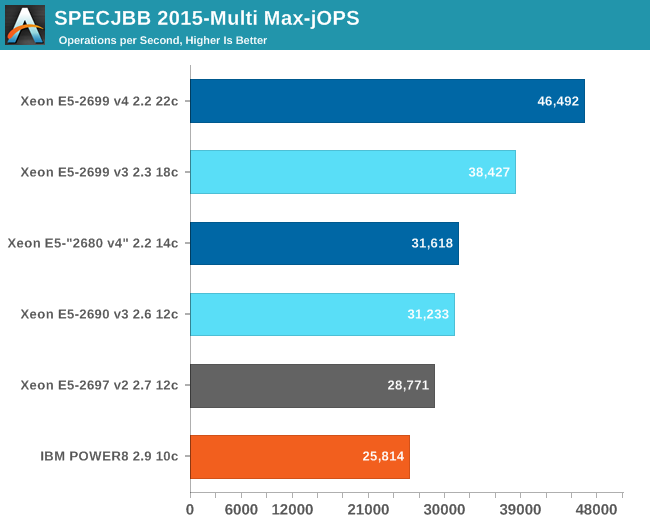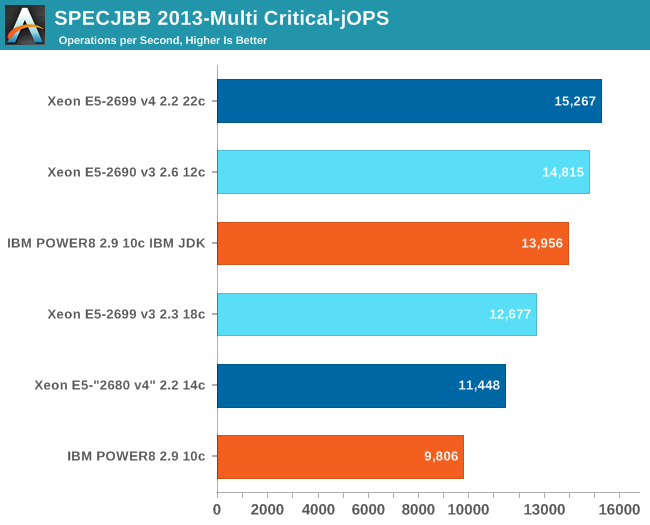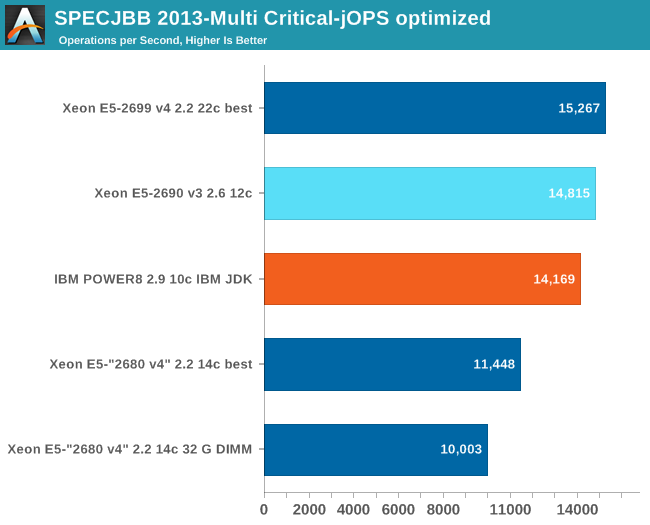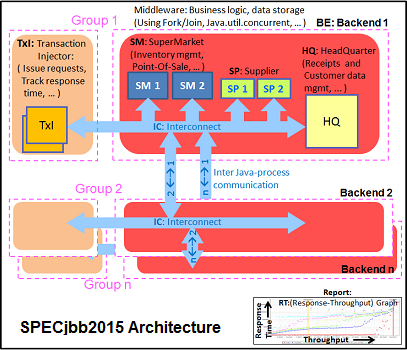Assessing IBM's POWER8, Part 2: Server Applications on OpenPOWER
by Johan De Gelas on September 15, 2016 8:01 AM ESTJava Performance
The SPECjbb 2015 benchmark has "a usage model based on a world-wide supermarket company with an IT infrastructure that handles a mix of point-of-sale requests, online purchases, and data-mining operations." It uses the latest Java 7 features and makes use of XML, compressed communication, and messaging with security.
We tested with four groups of transaction injectors and backends. The reason why we use the "Multi JVM" test is that it is more realistic: multiple VMs on a server is a very common practice.
The Java version was OpenJDK 1.8.0_91. We applied relatively basic tuning to mimic real-world use, while aiming to fit everything inside a server with 128 GB of RAM:
The graph below shows the maximum throughput numbers for our MultiJVM SPECJbb test.

The Critical-jOPS metric is a throughput metric under response time constraint.

After checking the other benchmarks and IBM's published benchmarks at spec.org we suspected that there was something suboptimal for the POWER8 server. A Java expert at IBM responded:
Currently OpenJDK 8 performance on power lags behind the IBM JDK for this benchmark, and is not reflective of the hardware. The gap is being closed by driving changes into OpenJDK 9 that will be back ported to OpenJDK 8.
So this is one of those cases where the "standard" open source ecosystem is not optimal. So we tried out IBM's 64 bit SDK version LE 8.0-3.11. Out of the box, throughput got even worse. Only when we used more complicated tuning and more memory...
...did performance get better. We also had to use static huge pages (16 MB each) instead of transparent huge pages. We gave the Intel Xeons also 32 GB per VM and eight 32 GB DIMMs, but we did not use the IBM JDK as it caused a performance decrease.

Both the Xeon and the IBM POWER8 max throughput got worse. In the case of Intel we can easily explain this: its 32 GB of DDR4-2133 memory offers less bandwidth and higher latency. In case of IBM, we can only say we lack knowledge of the IBM JDK.

Again, the Xeon E5-2680 v4 loses performance due to the fact that we had to use more but slower memory.
This is not an apples to apples comparison as we would like it, but it gives a good indication that the IBM POWER8 might actually able to beat even more expensive Xeon E5s than our (simulated) Xeon E5-2680v4 with optimized software. A Xeon E5-2690 v4 ($2090) would be beaten by a decent margin and even the 2695v4 ($2400) might be in reach.











49 Comments
View All Comments
nils_ - Monday, September 26, 2016 - link
Isn't the limit slighty lower than 32 GiB? At some point the JVM switches to 64 bit pointers, which means you'll lose a lot of the available heap to larger pointers. I think you might want to lower your settings. I'm curious, what kind of GC times are you seeing with your heap size? I don't currently have access to Java running on non virtualised hardware so I would like to know if the overhead is significant (mostly running Elasticsearch here).CajunArson - Thursday, September 15, 2016 - link
All in all the Power chip isn't terrible but the power consumption coupled with the sheer amount of tuning that is required just to get it competitive with the Xeons isn't too encouraging. You could spend far less time tuning the Xeons and still have higher performance or go ahead with tuning to get even more performance out of those Xeons.On top of the fact that this isn't a supposedly "high end" model, the higher end power parts cost more and will burn through even more power, and that's an expense that needs to be considered for the types of real-world applications that use these servers.
dgingeri - Thursday, September 15, 2016 - link
That ad on the last page that claims lower equipment cost of course compares that to an HP DL380, the most overpriced Xeon E5 system out right now. (I know because I shopped them.) Comparing it to a comparable Dell R730 would show less expense, better support, and better expansion options.Morawka - Thursday, September 15, 2016 - link
you mean a company made a slide that uses the most extreme edge cases to make their product look good?!?! Shocking /sGondalf - Thursday, September 15, 2016 - link
Something is wrong is these power consumption data. The plataform idles at 221W and under full load only 260W?? the cpu is vanished?? Power 8 at over 3Ghz has an active power of only 40W??1) the idle value is wrong or 2) the under load value is wrong. All this is not consistent with IBM TDP official values.
IMO the energy consumption page of the article has to be rewrite.
JohanAnandtech - Thursday, September 15, 2016 - link
We have double checked those numbers. It is probably an indication that many of the power saving features do not work well under Linux right now.BTW, just to give you an idea: running c-ray (floating point) caused the consumption to go to 361W.
Kevin G - Thursday, September 15, 2016 - link
I presume that c-ray uses the 256 bit vector unit on POWER8?Also have you done any energy consumption testing that takes advantage of the hardware decimal unit?
mapesdhs - Thursday, September 15, 2016 - link
C-ray isn't that smart. :D It's a very simple code, brute force basically, and the smaller dataset can easily fit in a modern cache (actually the middling size test probably does too on CPUs like these). Hmm, I suppose it's possible one could optimise the compilation a bit to help, but I doubt anything except a full rewrite could make decent use of any vector tech, and I don't want to allow changes to the code, that would make comparisons to all other test results null. Compiler optimisations are ok, but not multi-pass optimisations that feed back info about the target data into the initial compile, that's cheating IMO (some people have done this to obtain what look like really silly run times, but I don't include them on my main C-ray page).Ian.
Gondalf - Tuesday, September 20, 2016 - link
Ummm so in short words the utilized sw don't stress at all the cpu, not even the hot caches near the memory banks. We need a bench with an high memory utilization and a balanced mix between integer and FP, more in line with real world utilizationI don't know if this test is enough to say POWER8 is power/perf competitive with haswell in 22nm.
In fact POWER market share is definitively at the historic minimum and 14nm Broadwell is pretty young, so this disaster it is not its fault.
jesperfrimann - Wednesday, September 21, 2016 - link
If you have a OPAL (Bare Metal system that cannot run POWERVM) then all the powersavings features are off by default AFAIR.Try to have a look at:
https://public.dhe.ibm.com/common/ssi/ecm/po/en/po...
Many of the features does have a performance impact, ranging from negative over neutral to positive for a single one.
But Again. I think your comparison with 'vanilla' software stacks are relevant. This is what people would see out of the box with an existing software stack.
It is 101% relevant to do that comparison as this is the marked that IBM is trying to break into with these servers.
But what could be fun to see was some tests where all the Bells and Whistles were utilized. As many have written here.. use of Hardware supported Decimal Floating Point. The Vector Execution unit, the ability to do hardware assisted Memory Compression etc. etc.
// Jesper